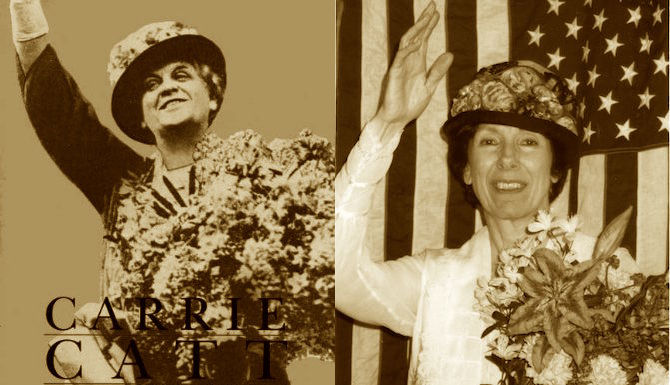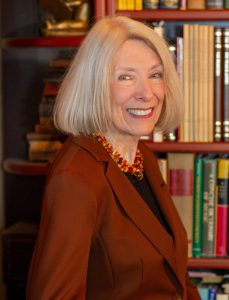
Event details
- August 25, 2020
- 7:00 pm - 8:30 pm
- Zoom - see link in text below
- (864) 596-3503
View Map | Cost: Free
At Home with Carrie Chapman Catt, Portrayed by Annette Baldwin
Join Carrie Chapman Catt, founder of the League of Women Voters, at home where she has returned from Washington DC after the 19th amendment granting America women the right to vote has been signed into law.
Before Carrie Chapman Catt, an Iowa school teacher, principal and superintendent of schools, was 30 years old, she began the work for which she is most known: a leader for woman suffrage. But Catt’s life must also be defined by her advocacy for international peace. she possessed astonishing skills of organization, diplomacy, strategy and oratory. In little over ten years, she succeeded Susan B Anthony, “Mother of the Cause” as president of the National American Woman Suffrage Association and “Mother of the Cause.” n 1900, Anthony personally passed the president’s gavel to Catt, whose 1915 “Winning Plan” for the Vote is now legendary. Six months before ratification of the 19th Amendment, in August 1920, Catt founded the League of Women Voters, to educate women to be independent, politically-informed citizens.
Please register in advance for this FREE Online ZOOM event. (Meeting room capacity is 300.) Everyone who registers for the meeting will receive a link to a recording of the program which will be available to view for one week.
REGISTER FOR: “CARRIE CHAPMAN CATT”
https://infodepot-org.zoom.us/meeting/register/tZMpceGrqT4qHNA_6DoE8m0dc_jjf_wm1DEK
(After registering, you will receive a confirmation email containing additional information about joining the meeting. If this is the first time you have attended a Zoom event, you may be directed to download the Zoom app. You do NOT need a Zoom account to attend.)
This event is hosted by the Spartanburg County Public Libraries.

 Annette Baldwin (Carrie Chapman Catt)
Annette Baldwin (Carrie Chapman Catt)
Annette Baldwin has been researching and performing first-person monologues since 1986 when she launched her portrayal of humanitarian and peace advocate Jane Addams. Baldwin’s First Person Portrayals, Visual Journeys Narratives and Readers Theater have been presented to audiences in 20 states. She has appeared at public libraries, educational institutions, community organizations, professional associations, state and federal government agencies, to the business community, at state and national conferences, special events and at historical societies and museums, including the National Museum of American History at the Smithsonian Institution in Washington, D.C. Baldwin, who resides in the Chicago suburbs, is also a former Illinois Humanities Road Scholar.
Past professional experience and personal discovery have inspired and guided Annette’s choices for performance and lecture topics. A deep admiration for the courage and devotion to advocacy for social change by 19th century through early 20th century women is the foundation for many of her programs, such as her portrayals of Jane Addams, Susan B. Anthony and Carrie Chapman Catt. Anthony and Catt also “appear” in Baldwin’s woman suffrage production, The Long Road to Victory, in which there are also vignettes of Lucretia Mott and Elizabeth Cady Stanton. Baldwin became interested in developing discussion on the California architect Julia Morgan, known primarily for William Randolph Hearst’s estate at San Simeon, California, when she was editor of the membership newsletter at the Chicago American Institute of Architects. Her interest in design and architecture can also be found in her Visual Journey Narratives of Mary Jane Colter, architect and designer for the Fred Harvey Company and the Santa Fe Railroad, as well as The Carnegie Library: Treasures on the Illinois Landscape for which she traveled the State of Illinois to photograph each of the 85 extant Carnegie libraries Her experience as a fashion director for Marshall Field’s, once Chicago’s iconic department store, influenced her research and performance as fashion designer Coco Chanel, as well as the Visual Journey The Arts and the Art of Dressing: 1920s Style.
Baldwin’s experience at many levels in community theater – directing and acting in particular – was not only the original driving force behind inaugurating her work as a solo performer and a lecturer, but it inspired her Readers Theater productions, Literary Lovers, By Necessity/ By Choice: Women in the Early Workplace, and Living the War: Women Inside the Confederate Capital. Having performed and lectured in the Chautauquas of Illinois, Missouri, Colorado, Nevada, Maryland, New Hampshire and Ohio, Baldwin has led dozens of programs with discussions on themes involving women’s social and political history, as well as fashion. StagingHistory.com
A dynamic speaker and tenacious organizer, Carrie Chapman Catt was a powerful force in the women’s suffrage movement. Her relentless campaigning won Woodrow Wilson’s respect and support, and ultimately led to passage of the Nineteenth Amendment granting women the right to vote.
Born in Wisconsin in 1859, Carrie Lane moved with her family to Iowa at the age of seven. She graduated from Iowa State University as the only woman in her class and soon began work as a teacher, principal, and school superintendent. She married newspaper editor Leo Chapman in 1885, but their marriage was cut short one year later when he died suddenly of typhoid fever. Four years later, she married wealthy engineer George Catt.
Carrie Chapman Catt took her first step as a political activist in 1886 when she joined the Iowa Woman Suffrage Association. She soon served as a delegate to the newly formed National American Woman Suffrage Association (NAWSA). By 1900, Catt succeeded the 80-year-old activist Susan B. Anthony as its president. She took the fight for women’s rights to the world stage, organizing the International Woman’s Suffrage Association in 1902. She chose to curtail much of her suffrage work in 1904, though, to care for her ailing husband.
In the years following her husband’s 1905 death, a grieving Catt resumed her work, concentrating on women’s rights in the international arena. Under other leadership, the national organization, NAWSA, became divided, sorely in need of Catt’s energy and direction. Catt was not a firebrand suffragist; rather, she worked on many fronts and used compromises to advance her cause strategically.
After hearing Catt address a women’s suffrage convention in Canton, New York in 1914, a reporter described her speech as factual, conciliatory and delivered so as not to offend.
After reassuming leadership of NAWSA in 1915, she clashed with the faction led by the far more combative Alice Paul, who wanted to work for a constitutional amendment only at the federal level. Catt saw that suffrage at the state level could help strengthen the movement for a Constitutional amendment — and where complete state suffrage could not be enacted, Catt would settle for a partial solution. The schism led Paul’s faction to abandon NAWSA and form what would become the National Woman’s Party. But it was Catt’s leadership – progressive but not radical – that finally led President Wilson to throw his support behind the amendment.
Fifty-one years after Susan B. Anthony and Elizabeth Cady Stanton founded NAWSA, the Nineteenth Amendment gave women the vote in 1920. Following this victory,Catt helped establish the League of Women Voters to give American women guidance in using their new franchise. (Catt sold some of her sapphire jewelry to help start the League of Women Voters.)
In her later years, Catt spoke on behalf of working women, worked for pacifism, organized the National Conference on the Cause and Cure of War, and lobbied for Jewish refugee relief efforts. Shortly before her death in New Rochelle, New York in 1947, she would even lend her hand in the founding of the United Nations.
1880 Graduated from Iowa Agricultural College (now Iowa State University), Ames, Iowa
1883-1884 Superintendent of schools, Mason City, Iowa
1884 Married Lee Chapman (died 1886), newspaper editor and publisher
1890 Married engineer George Catt (died October 1905) Delegate to National American Woman Suffrage Association
1890-1900 Worked with organization committee, National American Woman Suffrage Association
1900-1904 President, National American Woman Suffrage Association
1900-1920 Worked for woman suffrage through an amendment to the U.S. Constitution
1904-1923 President, International Woman Suffrage Alliance
1911-1912 Made world tour for the suffrage cause
1915-1920 Returned to the United States and resumed as president, National American Woman Suffrage Association
1915 Organized Woman’s Peace Party with Jane Addams
1916 Devised “Winning Plan” to campaign for suffrage on federal and state levels
1919 Helped found the National League of Women Voters
The vote is the emblem of your equality, women of America, the guarantee of your liberty.
This world taught woman nothing skillful and then said her work was valueless. It permitted her no opinions and said she did not know how to think. It forbade her to speak in public and said the sex had no orators.
Just as the world war is no white man’s war, but every man’s war, so is the struggle for woman suffrage no white woman’s struggle, but every woman’s struggle.
Everybody counts in applying democracy. And there will never be a true democracy until every responsible and law-abiding adult in it, without regard to race, sex, color or creed has his or her own inalienable and unpurchasable voice in government.
On August 26, 1920, Carrie Chapman Catt celebrated the winning of the vote for women with a speech including these words:
The vote is the emblem of your equality, women of America, the guarantee of your liberty. That vote of yours has cost millions of dollars and the lives of thousands of women. Money to carry on this work has been given usually as a sacrifice, and thousands of women have gone without things they wanted and could have had in order that they might help get the vote for you. Women have suffered agony of soul which you can never comprehend, that you and your daughters might inherit political freedom. That vote has been costly. Prize it!
The vote is a power, a weapon of offense and defense, a prayer. Understand what it means and what it can do for your country. Use it intelligently, conscientiously, prayerfully. No soldier in the great suffrage army has labored and suffered to get a “place” for you. Their motive has been the hope that women would aim higher than their own selfish ambitions, that they would serve the common good,
The vote is won. Seventy-two years the battle for this privilege has been waged, but human affairs with their eternal change move on without pause. Progress is calling to you to make no pause. Act!
*Suffrage : women’s long battle for the vote by Ellen Carol Dubois (2020)
Why They Marched by Susan Ware
*The Women’s Suffrage Movement by Sally Roesch Wagner
*The Woman’s hour: the great fight to win the vote by Elaine F. Weiss
*Mr. President, how long must we wait? : Alice Paul, Woodrow Wilson and the fight for the right to vote by Tina Cassidy
(Starred items are available in the Greenville County Library System.)
